The diode used in figure requires minimum current of 1 mA to be above the knee voltage 0.7 of current versus voltage characteristics. The maximum value of R so that the voltage is above knee point is :
 Solution in Kannada
Solution in Kannada
5kΩ
5.7kΩ
4.3kΩ
3.5kΩ
The correct Answer is:C
i=VF−VBR
⇒R=VF−VBi=5−0.710−3=4.3×103Ω
=4.3kΩ
Topper's Solved these Questions
- BOOK - MODERN PUBLICATIONCHAPTER - SOLIDS & SEMICONDUCTOR DEVICESEXERCISE - Multiple Choice Questions - LEVEL -I (ASSERTION)5videos
SOLIDS & SEMICONDUCTOR DEVICES
- BOOK - MODERN PUBLICATIONCHAPTER - SOLIDS & SEMICONDUCTOR DEVICESEXERCISE - Multiple Choice Questions - LEVEL -I (PARAGRAPH)6videos
SOLIDS & SEMICONDUCTOR DEVICES
- BOOK - MODERN PUBLICATIONCHAPTER - ROTATIONAL MOTIONEXERCISE - RCQ8videos
ROTATIONAL MOTION
- BOOK - MODERN PUBLICATIONCHAPTER - TRANSFERENCE OF HEAT EXERCISE - Recent Competitive Questions4videos
TRANSFERENCE OF HEAT
Similar Questions
Statement I : In N - type semiconductor , the free electron concentration approximately equals the density of donor atoms .
Statement II : In a forward biased P - N - region is proportional to the change Q of the injected minority carrier holes.02:57View SolutionIn a triode value for a grid voltage Vg=−1.2V , the phase current Ip and plate voltage Vp are given Ip=(−5+0.1V0),Ip in mAandVp in volt . When grid voltage is changed to - 3.2 V at constant plate voltage of 150 V , a plate current of 5 mA is observed , then
Plate resistance Rp is02:57View SolutionThe moment of inertia of a circular disc of radius 2 m and mass 1 kg about an axis passing through the centre of mass but perpendicular to the plane of the disc is 2 kg m2. Its moment of inertia about an axis parallel to this axis but passing through the edge of the disc is :
 03:34View Solution
03:34View SolutionTwo slabs are of the thicknesses d1 and d2. Their thermal conductivities are K1 and K2 respectively They are in series. The free ends of the combination of these two slabs are kept at temperatures θ1 and θ2. Assume θ1>θ2. The temperature θ of their common junction is
View SolutionThe junction diode in the following circuit requires a minimum current of 1mA to be above the knee point (0.7V) of its I−V characterstic curve. The voltage across the diode is independent of current above the knee point. If VB=5V, then the maximum value of R so that the voltage is above the knee point, will be
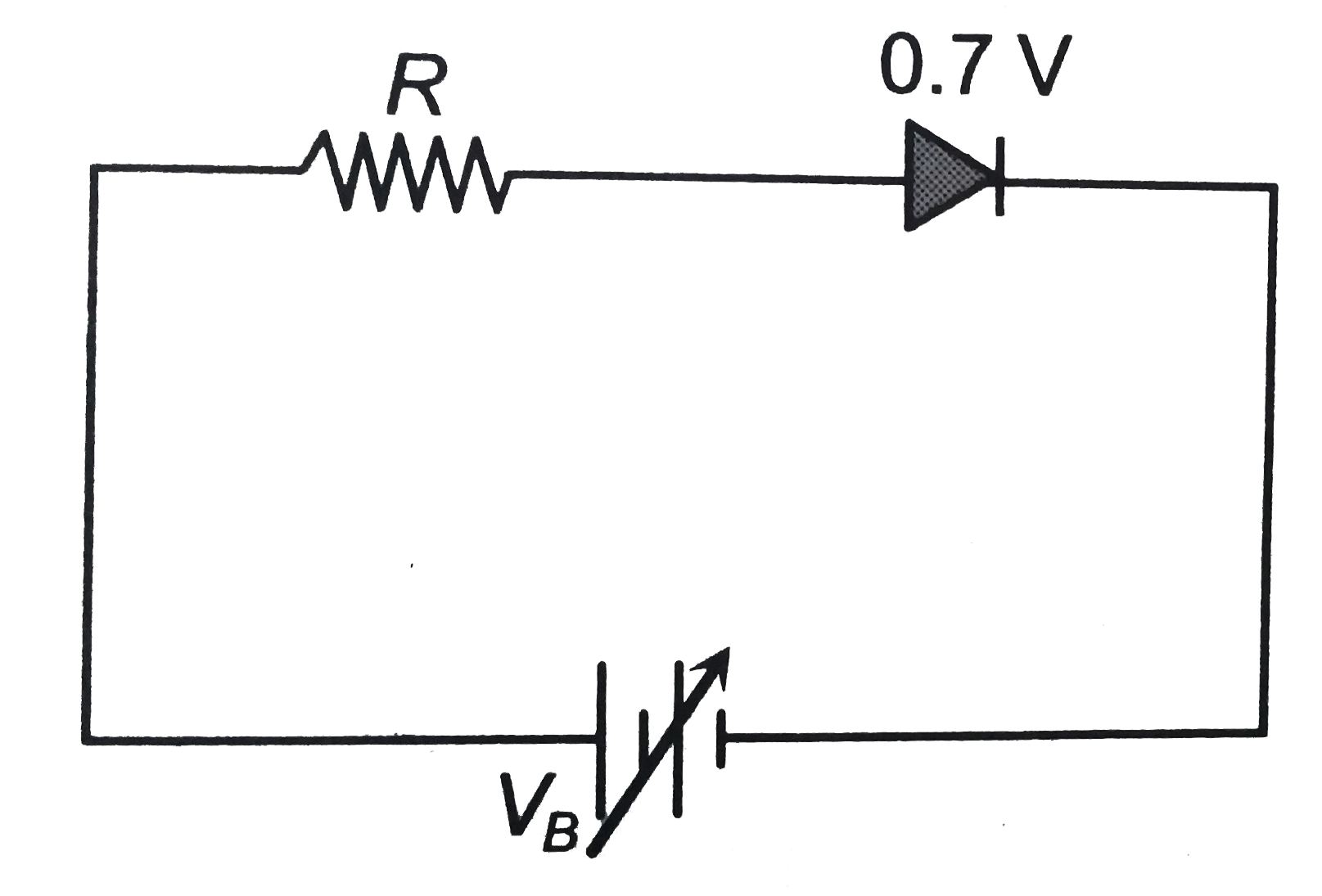 03:50View Solution
03:50View SolutionAssume that silicon diode in the circuit Fig. requires minimum current of 1 mA to be above the knee point (0.7 V) of its I-V characteristics. Also assume that the voltage across the diode is independent of current above the knee point. If V_(B)=5V , what should be the minimum value of R so that the voltage is above the knee point? If V_(B)=5V , what should be the value of R to establish the current of 5mA in the circuit? What is the power dissipated in the resistance R and in the diode, when a current of 5mA flows in the circuit at V_(B)=6V . If R=1kOmega , what is the minimum voltage V_(B) required to keep the diode above the knee point?
02:19View SolutionAssume that the silicon diode in the given circuit requires a minimum current of 1 mA to be above the (knee-point voltage = 0.7 V) of its I−V characteristics. Assuming that the voltage across the diode is independent of current above the knee-point, find the maximum value of R so that the voltage is above the knee-point if VB=5A. Also find the value of R to establish a current of 5 mA in the circuit for the since voltage.
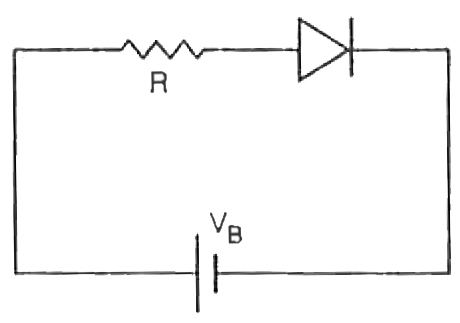 01:56View Solution
01:56View SolutionAssume that the silicon diode in the circui shown in fig. requires a minimum current of 1mA to be above the knee point (0.7V) of its I−V characteristics. Aslo assume that the voltage across the diode is independent of current above the knee point.
(a) If VB=5V, what should be the maximum value of R so that the voltage is above the knee point?
(b) If VB=5V, what should be the value of R to estabilish the current of 5mA in the circuit?
(c) What is the power dissipated in the resistance R and in the diode, when a current of 5mA flows in the circuit at VB=6V?
(d) If R=1kΩ, what is the minimum voltage VB required to keep the diode above the knee point?08:13View SolutionThe source voltage is 9 volt and source resistance is 1kOmega The current through the silicon diode is (knee voltage of silicon is 0.7 volt):
03:26View SolutionThe junction diode in the following circuit requires a minimum current of 1 mA to be above the knee point (0.7V) of its 1-V characteristic curve . The voltage across the diode is independent of current above the knee point . If VB=5V , then the maximum value of R so that the voltage is above the knee point will be
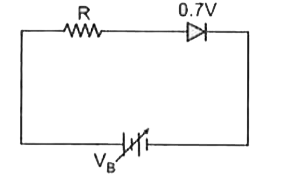 01:03View Solution
01:03View SolutionIn the current versus voltage characteristics of a diode minimum current of 1 mA is required for the knee voltage to be is connected in a cirucit the minimum value of R so that the voltage is above knee point is
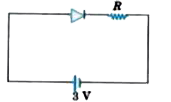 02:26View Solution
02:26View Solutionमान लें कि परिपथ [चित्र ] में सिलिकॉन डायोड को अपने I-V अभिलाक्षणिक के घुटना-बिंदु (knee point ) ( 0.7 V ) से ऊपर होने के लिए 1 mA की न्यूनतम धारा की आवश्यकता है। यह भी मान लें कि डायोड के सिरों पर वोल्टता, घुटना -बिंदु से ऊपर धारा पर निर्भर नहीं।
(a) यदि VB=5V, तो R का अधिकतम मान क्या होना चाहिए कि वोल्टता, घुटना -बिंदु से ऊपर चाहिए ?
(b) यदि VB=5V, तो परिपथ में 5mA की धारा स्थापित करने के लिए R का क्या मान होना चाहिए ?
( c ) जब VB=6V पर परिपथ में 5 m A धारा बहे, तो प्रतिरोध R और डायोड में कितनी शक्ति क्षयित होती है ?
(d ) यदि R=1kΩ, तो डायोड को घुटना -बिंदु से ऊपर रखने के लिए कितनी निम्नतम वोल्टता Vn आवश्यक है ?
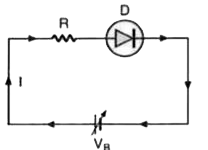 View Solution
View SolutionThe low circuit in a semiconductor diode requires a minimum current of 1 mA above the (IV) transient curve (0.7V). The knee-point charged on the diode is independent of the current. If V_(B) = 4 What is the maximum value of R if the voltage is so that the voltage is above the Ni-point?
View SolutionShow the knee-voltage and breakdown voltage by drawing the characteristic curves for a junction diode.
View SolutionThe junction diode in the following circuit requires a minimum current of 1mA to be above the knee point (0.7V) of its I−V characterstic curve. The voltage across the diode is independent of current above the knee point. If VB=5V, then the maximum value of R so that the voltage is above the knee point, will be
 View Solution
View Solution

